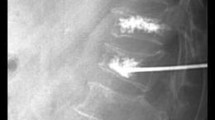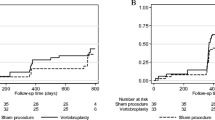Abstract
The aim of this study was:to assess the long-term efficacy and safety of percutaneous vertebroplasty (PVP) for treating painful vertebral osteoporotic fractures, and to estimate the risk of vertebral fracture in the vicinity of a cemented vertebra. A prospective open study was conducted. PVP were carried out between July 1995 and September 2000 for 16 patients with symptomatic osteoporotic vertebral fracture that had not responded to extensive conservative medical therapy. All the patients were followed-up for more than 1 year. The efficacy of the PVP was assessed by the changes over time in pain on Huskisson’s visual analog scale (VAS) and on the McGill-Melzack scoring system (MGM). The efficacy of the procedure was also assessed by measuring the changes over time in quality of life assessed by the Nottingham Health Profile (NHP instrument): twenty-one vertebrae treated by PVP in 16 patients were evaluated. The mean duration of follow-up was 35 months. Pain assessed by the VAS significantly decreased from a mean of 71.4 mm±13 before PVP to 36 mm±30 after 6 months, and to 39 mm±33 at the time of maximal follow-up (p<0.05 for both comparisons). The results were also significant for the MGM: 3.00±0.57 before PVP to 1.6±1.4 at the long-term follow-up (p<0.05). The solely statistically significant decrease for quality of life was noted for pain. A slight but not significant improvement was noted for 3/6 dimensions of the NHP scores. A slight but significant increase in social isolation was also found. No severe complication occurred immediately after PVP. At the long term follow-up (35 months) there was a slight but not significantly increased risk of vertebral fracture in the vicinity of a cemented vertebra: odds ratio 3.18 (95% confidence interval (CI) 0.51–19.64). The odds ratio of a vertebral fracture in the vicinity of an uncemented fractured vertebra was 2.14 (95% CI: 0.17–26.31). In conclusion, PVP appears to be safe and effective for treating persistent painful osteoporotic fractures. Controlled studies with long-term follow-up are needed to evaluate the risk of vertebral fractures in the vicinity of a cemented vertebra.




Similar content being viewed by others
Abbreviations
- MGM:
-
McGill-Melzack scoring system
- PVP:
-
Percutaneous vertebroplasty
- VAS:
-
Visual analog scale
References
Cotten A, Boutry N, Cortet B et al. (1998) Percutaneous vertebroplasty: state of the art. Radiographics 18:311–320
Galibert P, Deramond H, Rosat P et al. (1987) Note préliminaire sur le traitement des angiomes vertébraux par vertébroplastie acrylique percutanée. Neurochirurgie 33:166–168
Deramond H, Darrasson R, Galibert P (1989) Percutaneous vertebroplasty with acrylic cement in the treatment of aggressive spinal angiomas. Rachis 1:143–153
Cotten A, Duquesnoy B (1997) Vertebroplasty: current data and future potential. Rev Rhum Engl Ed 64:645–649
Chiras J, Depriester C, Weill A et al. (1997) Vertébroplasties percutanées. Technique et indications. J Neuroradiol 24:45–59
Jensen ME, Evans AJ, Mathis JM et al. (1997) Percutaneous polymethylmethacrylate vertebroplasty in the treatment of osteoporotic vertebral body compression fractures: technical aspects. AJNR 18:1897–904
Mathis J, Petri M, Naf N. (1998) Percutaneous vertebroplasty treatment of steroid-induced osteoporotic compression fractures. Arthritis Rheum 41:171–175
Cortet B, Cotten A, Boutry N et al. (1999) Percutaneous vertebroplasty in the treatment of osteoporotic vertebral compression fractures: an open prospective study. J Rheumatol 26:2222–2228
Hardouin P, Grados F, Cotten A et al. (2001) Should percutaneous vertebroplasty be used to traet osteoporotic fractures? An update. Joint Bone Spine 68:216–221
Bascoulergue Y, Duquesnel J, Leclercq R et al. (1988) Percutaneous injection of methylmetacrylate in the vertebral body for the treatment of various diseases. Radiology 169:372 (abstract)
Cortet B, Houvenagel E, Puisieux F et al. (1999) Spinal curvatures and quality of life in women with vertebral fractures secondary to osteoporosis. Spine 15:1921–925
Cortet B, Roches E, Logier R et al. (2002) Evaluation of spinal curvatures after a recent osteoporotic vertebral fracture. Joint Bone Spine 69:201–208
Weill A, Chiras J, Simon JM et al. (1996) Spinal metastases: indications for and results of percutaneous injection of acrylic surgical cement. Radiology 199:241–247
Melzack R (1975) The McGill pain questionnaire: major properties and scoring methods. Pain 1:275–279
Hunt S, McEwen J, McKenna S (1985) Measuring health status: a new tool for clinicians and epidemiologists. J Roy Coll Gen Pract 35:185–188
Genant HK, Wu CY, Van Kuijk C et al. (1993) Vertebral fracture assessment using a semiquantitative technique. J Bone Miner Res 8:1137–1148
Lapras C, Mottolese R, Deruty R et al. (1989) Injection percutanée de méthyl-méthacrylate dans le traitement de l’ostéoporose et ostéolyse vertébrale grave (technique de P. Galibert). Ann Chir 43:371–376
Debussche-Depriester C, Deramond H, Fardellone P et al. (1991) Percunaeous vertebroplasty with acrylic cement in the treatment of osteoporotic vertebral crush fracture syndrome. Neuradiology 33:149–152
Gangi A, Kastler BA, Dietemann JL (1994) Percutaneous vertebroplasty guided by a combination of CT and fluoroscopy. AJNR 15:83–86
Deramond H, Depriester C, Galibert P et al. (1998) Percutaneous vertebroplasty with polymethylmethacrylate. Technique, indications, and results. Radiol Clin North Am 36:533–546
Martin JB, Jean B, Sugiu K et al. (1999) Vertebroplasty: clinical experience and follow-up results. Bone 25:11S–15S
Cyteval C, Baron Sarrabère MP, Roux JO et al. (1999) Acute osteoporotic vertebral collapse: open study on percutaneous injection of acrylic surgical cement in 20 patients. AJR 173:1685–1690
Heini PF, Walchli B, Berlemann U (2000) Percutaneous transpedicular vertebroplasty with PMMA: operative technique and early results. A prospective study for the treatment of osteoporotic compression fractures. Eur Spine J 9:445–450
Grados F, Depriester C, Cayrolle G et al. (2000) Long-term observations of osteoporotic fractures treated by percutaneous vertebroplasty. Rheumatology 39:1410–1414
Barr JD, Barr MS, Lemley TJ et al. (2000) Percutaneous vertebroplasty for pain relief and spinal stabilization. Spine 25:923–928
O’Brien JP, Sims JT, Evans AJ (2000) Vertebroplasty in patients with severe vertebral compression fractures: a technical report. Am J Neuroradiol 21:1555–1558
Diamond TH, Clark A (2001) Percutaneous vertebroplasty: a novel treatment for acute vertebral fractures. Med J Aust 174:398–400
Padovani B, Kasriel O, Brunner P et al. (1999) Pulmonary embolism caused by acrylic cement: a rare complication of percutaneous vertebroplasty. AJNR 20:375–377
Chiras J, Deramond H (1995) Complications des vertébroplasties. In: Saillant G, Laville C, eds. Echec et complications de la chirurgie du rachis: chirurgie de reprise. Paris, Sauramps Medical, pp 149–153
Cotten A, Dewattre F, Cortet B et al. (1996) Percutaneous vertebroplasty for treatment of osteolytic metastases and myeloma: effect of percentage of lesion filling and the leakage of methylmethacrylate at clinical follow-up. Radiology 200:525–530
Lieberman IH, Dudeney S, Reinhardt MK et al. (2001) Initial outcome and efficacy of kyphoplasty in the treatment of painful osteoporotic vertebral compression fractures. Spine 14:1631–1638
Author information
Authors and Affiliations
Corresponding author
Rights and permissions
About this article
Cite this article
Legroux-Gérot, I., Lormeau, C., Boutry, N. et al. Long-term follow-up of vertebral osteoporotic fractures treated by percutaneous vertebroplasty. Clin Rheumatol 23, 310–317 (2004). https://doi.org/10.1007/s10067-004-0914-7
Received:
Accepted:
Published:
Issue Date:
DOI: https://doi.org/10.1007/s10067-004-0914-7




